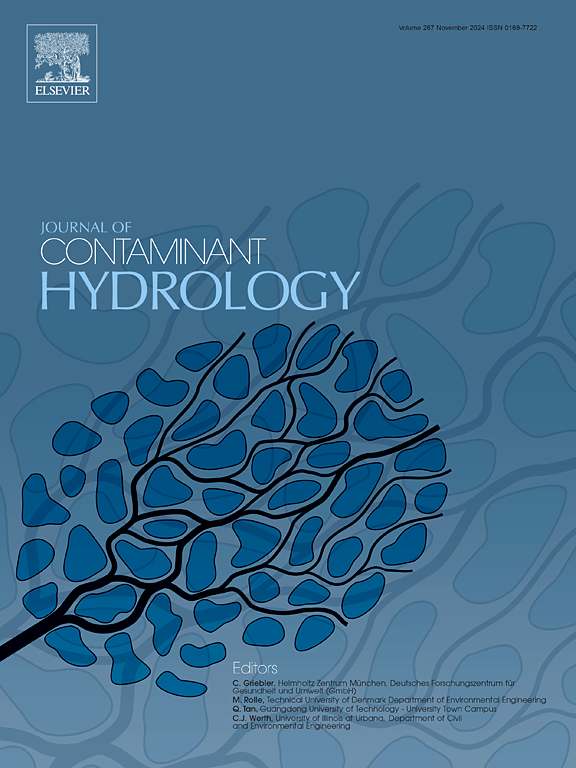The impacts of water transfer on water quality under internal and external nutrient load in Chaohu Lake
IF 4.4
3区 环境科学与生态学
Q2 ENVIRONMENTAL SCIENCES
引用次数: 0
Abstract
Water transfer can alleviate the uneven distribution of regional water resources and improve the eutrophication status of water bodies in the receiving regions. However, few studies have quantitatively analyzed water quality changes in eutrophic lakes under water division considering the effects of internal and external nutrient load. Chaohu Lake, a large shallow lake in East China, was used as an example. Daily meteorological, hydrological, and water quality data for 2023–2024 were applied to develop a coupled hydrodynamic-water quality model using the Environmental Fluid Dynamics Code, considering seasonal sediment release of ammonia, phosphate, and nitrate. Based on this model, the seasonal contributions to nutrient loads from internal and external sources were quantified. Water transfer scenarios were employed to simulate and compare the spatial and temporal changes in the water level and water quality of Chaohu Lake. The results demonstrated that: 1) The simulated values of the water level, water temperature, and water quality parameters (including TN, TP, and DO) fit well with the measured values, thus confirming the reliability of the model. 2) The annual endogenous release of phosphorus and nitrogen accounted for 76.8 % and 75.3 % of the total load from internal and external sources, respectively. 3) Water transfer measures significantly altered the hydrological conditions of the lake, exacerbated seasonal fluctuations in nutrients, and increased sediment release, leading to an increase in TP concentration, and decrease of TN and DO. Under the four water transfer scenarios, the water transfer path of diverting water into Chaohu Lake (150 m3/s) through Zhao River and using the Baishitian River as the outlet significantly improved the water quality of the entire lake, with 5.03 % decrease in TN concentration and a minimum increase (14.29 %) of TP. This study provides a scientific basis for water diversion scheduling and eutrophication regulation in lakes.
内外养分负荷下巢湖调水对水质的影响
调水可以缓解区域水资源分布的不均衡,改善受水地区水体的富营养化状况。然而,对富营养化湖泊在分水条件下考虑内外营养物负荷影响的水质变化进行定量分析的研究较少。以中国东部大型浅湖巢湖为例。利用2023-2024年的每日气象、水文和水质数据,利用环境流体动力学规范建立了一个耦合的水动力-水质模型,考虑了氨、磷酸盐和硝酸盐的季节性沉积物释放。在此模型的基础上,量化了内源和外源养分负荷的季节性贡献。采用调水情景对巢湖水位和水质的时空变化进行了模拟和比较。结果表明:1)水位、水温、水质参数(TN、TP、DO)的模拟值与实测值拟合较好,验证了模型的可靠性。2)磷和氮的年内源释放量分别占内源和外源总负荷的76.8%和75.3%。3)调水措施显著改变了湖泊水文条件,加剧了营养物的季节波动,增加了沉积物释放,导致TP浓度升高,TN和DO降低。4种调水方案下,经赵河调水入巢湖(150 m3/s)、以白石田河为出水口的调水路径显著改善了整个湖的水质,TN浓度降低5.03%,TP浓度增加最小(14.29%)。该研究为湖泊引水调度和富营养化调控提供了科学依据。
本文章由计算机程序翻译,如有差异,请以英文原文为准。
求助全文
约1分钟内获得全文
求助全文
来源期刊

Journal of contaminant hydrology
环境科学-地球科学综合
CiteScore
6.80
自引率
2.80%
发文量
129
审稿时长
68 days
期刊介绍:
The Journal of Contaminant Hydrology is an international journal publishing scientific articles pertaining to the contamination of subsurface water resources. Emphasis is placed on investigations of the physical, chemical, and biological processes influencing the behavior and fate of organic and inorganic contaminants in the unsaturated (vadose) and saturated (groundwater) zones, as well as at groundwater-surface water interfaces. The ecological impacts of contaminants transported both from and to aquifers are of interest. Articles on contamination of surface water only, without a link to groundwater, are out of the scope. Broad latitude is allowed in identifying contaminants of interest, and include legacy and emerging pollutants, nutrients, nanoparticles, pathogenic microorganisms (e.g., bacteria, viruses, protozoa), microplastics, and various constituents associated with energy production (e.g., methane, carbon dioxide, hydrogen sulfide).
The journal''s scope embraces a wide range of topics including: experimental investigations of contaminant sorption, diffusion, transformation, volatilization and transport in the surface and subsurface; characterization of soil and aquifer properties only as they influence contaminant behavior; development and testing of mathematical models of contaminant behaviour; innovative techniques for restoration of contaminated sites; development of new tools or techniques for monitoring the extent of soil and groundwater contamination; transformation of contaminants in the hyporheic zone; effects of contaminants traversing the hyporheic zone on surface water and groundwater ecosystems; subsurface carbon sequestration and/or turnover; and migration of fluids associated with energy production into groundwater.
 求助内容:
求助内容: 应助结果提醒方式:
应助结果提醒方式:


